MyPortugalHoliday.com
The best independent guide to Central Portugal
MyPortugalHoliday.com
The best independent guide to Central Portugal
Obidos: sights and attractions for 2026
Óbidos is one of central Portugal's most captivating destinations and is perfect for a day trip from Lisbon.
This medieval gem, with its whitewashed houses, winding cobblestone streets, and imposing castle, is often regarded as one of Portugal's most beautiful towns.
The town's fascinating royal heritage dates back to 1214, when it became a traditional wedding gift for Portuguese queens, a custom that continued until the 19th century. This royal patronage helped preserve Óbidos' distinctive character and architectural integrity.
Despite its small size, Óbidos offers a rich variety of attractions and historical landmarks. This guide covers the town's key sights to help you get the most out of your visit.
Related articles: Obidos Introduction – Day trip to Obidos
Top 12 Attractions in Óbidos
Óbidos offers a wealth of historic and cultural attractions. Key sites to explore include:
Porta da Vila: Main entrance with stunning chapel and azulejo tiles above the gateway.
Town Walls: 1.5km walkable fortifications offering panoramic views of town and countryside.
Ginjinha d'Obidos: Sweet cherry liqueur served in chocolate cups along
Rua Direita.
Castelo de Óbidos: Medieval fortress turned luxury hotel with rich royal history.
Rua Direita: Main street bustling with handicraft stalls and tourist shops.
Igreja de Santa Maria: Historic church with Renaissance architecture and royal wedding site.
Pelourinho de Óbidos: 15th-century granite pillory in Praça de Santa Maria.
Aqueduto de Óbidos: 16th-century aqueduct with 127 arches, still supplying water today.
Santuário do Senhor Jesus da Pedra: Unique hexagonal baroque church outside town walls.
Museu Municipal de Óbidos: 18th-century manor showcasing local art and historical artifacts.
Igreja São Pedro: Baroque-Neoclassical church housing Josefa de Óbidos grave.
Capela de São Martinho: Intact medieval Gothic chapel.
The interactive map below shows the location of the main sights of Óbidos along with recommended dining spots. (Note: zoom in or out to see all of the points)
Legend:
1) Porta da Vila
2) Town Walls
3) Castelo de Óbidos
4) Rua Direita
5) Igreja de Santa Maria
6) Pelourinho de Óbidos
7) Aqueduto de Óbidos
8) Santuário do Senhor Jesus da Pedra
9) Museu Municipal de Óbidos
10) Igreja São Pedro
11) Capela de São Martinho
Recommended places to eat:
12) Ja!mon Ja!mon
13) Nova Casa de Ramiro
14) Tasca Torta
15) Alcaide
16) Pontinha
17) O Melro
For a full guide to the sights of the Óbidos region please see this guide
The following section offers in-depth information about Óbidos' primary attractions.
The Porta da Vila
The Porta da Vila serves as the main entrance to Óbidos; its unassuming exterior belies the beauty within. As you pass through, you'll find yourself beneath a stunning chapel that straddles the main thoroughfare.
This gateway, originally constructed in the 14th century, was rebuilt in the 17th century under the orders of King João IV. Look up as you enter, and you'll see the king's coat of arms proudly displayed above the arch. The structure was further remodelled in the 18th century, gaining its current Baroque style.
Inside, blue and white azulejo tiles from 1740 adorn the walls, depicting scenes from Christ's passion. The ceiling is lined with coloured tiles representing the Crown of Thorns, creating a striking visual effect.
The gateway's design is as functional as it is beautiful. It consists of two small, offset entrances - a clever medieval defensive feature. This layout prevented cavalry from charging directly into the town and made it difficult for attackers to use battering rams effectively.
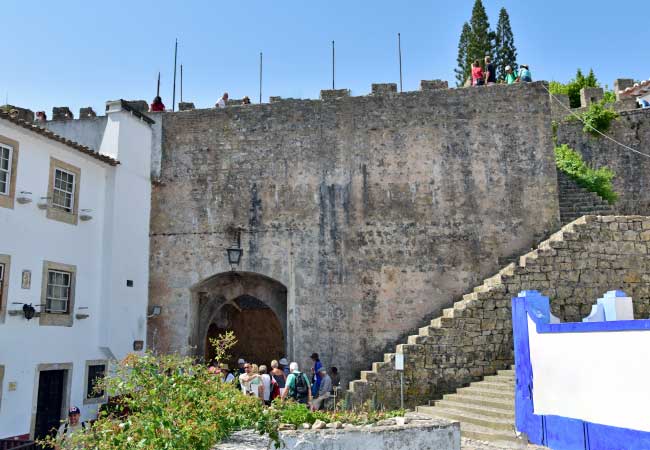
The small Porta da Vila was the main gate into the medieval town
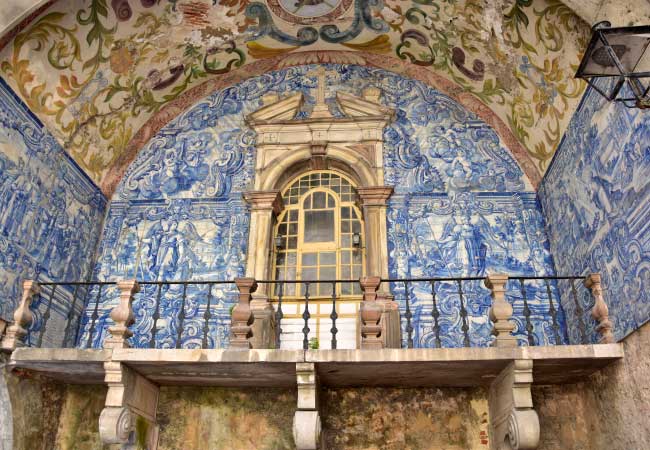
The beautiful tile paints of the Porta da Vila
Have you considered an organised tour?
A guided tour can offer valuable insights into Óbidos' rich history and culture. We have worked with Getyourguide.com for the last seven years and some of their best tours include:
The town walls of Óbidos
The town walls of Óbidos extend for 1.5km around the town's perimeter, reaching heights of up to 13m in some sections. These fortifications have a long and layered history, with their origins dating back to the Moorish era (8th-12th century). Early Portuguese rulers further reinforced them, but the walls you'll explore today largely date from the 18th century, having been restored after the devastating 1755 earthquake.
You can walk along the walls from the Porta da Vila to the castle, and there is a second access point on the western side near the Rua da Talhada. This western side offers particularly stunning views over the town and surrounding countryside.
Interestingly, up until the 16th century, the sea reached close to the base of the hill to the west of Óbidos, making it an important port.
Warning: Exercise caution when walking the town's walls. The surface can be uneven and worn in places, and there are no handrails for support.
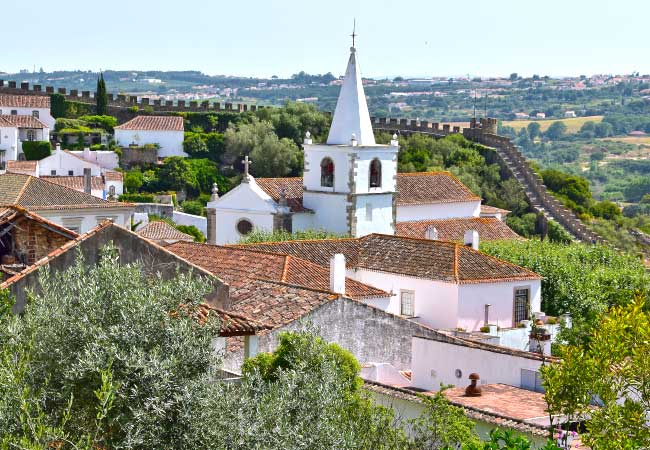
The walls completely encircle Óbidos
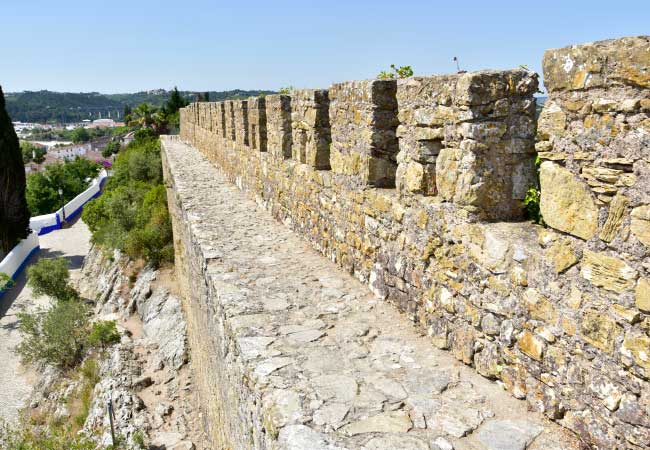
Care should be taken when walking around the walls.
Ginjinha d’Obidos (Ginja)
Ginjinha d'Óbidos is a deliciously sweet cherry liqueur, a local delicacy of the region. This traditional drink is made by infusing sour cherries (ginja berries) in aguardente (Portuguese brandy) with sugar and sometimes spices like cinnamon or cloves. You can enjoy Ginjinha in two main varieties: "sem elas" (without cherries) or "com elas" (with whole cherries in the glass). In Óbidos, it's famously served in small edible chocolate cups, a unique twist that has boosted its popularity.
Along the Rua Direita, you'll find numerous bars and stalls selling Ginjinha. A glass typically costs €1, or €1.50 if served in a chocolate cup. A bottle of Ginjinha also makes for a great souvenir to take home.
Insight: Ginjinha holds a nostalgic place in Portuguese culture. Up until the 1960s, it was commonly given to children as a remedy for colds and minor illnesses.
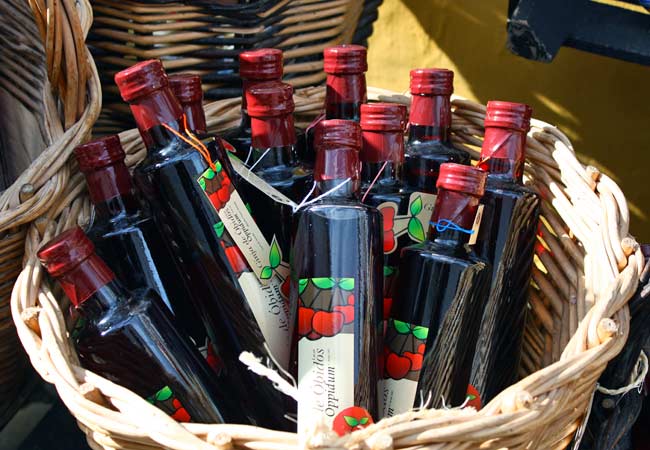
Castelo de Óbidos (Obidos Castle)
The Castelo de Óbidos is a classic medieval fortress situated at the highest point of Óbidos. Its solid stone walls, impregnable keep, and defensive battlements have guarded Óbidos for centuries. While a castle has stood here since the Moorish occupation in the 8th century, the current structure largely dates from the 13th century.
King Afonso I conquered the site in 1148 during the Christian Reconquista. His successor, King Afonso II, expanded the castle in 1210 and gifted it to his wife, beginning the tradition of Óbidos as a wedding present to Portuguese queens. Under King Dom Dinis, the castle took on its present form, featuring a blend of Gothic and Baroque architectural styles.
The castle has weathered significant events in Portuguese history. It suffered damage during the 1755 Lisbon earthquake and again in 1808 during the Battle of Roliça against Napoleon's forces. Despite these challenges, it remained an important royal venue for weddings, coronations, and celebrations.
In 1951, the castle was transformed into a luxury hotel (pousada). As it is now an operating hotel, access to the interior is generally reserved for guests. However, you can freely explore the outer battlements and the main courtyard, which still offer a fantastic sense of the castle's medieval grandeur.
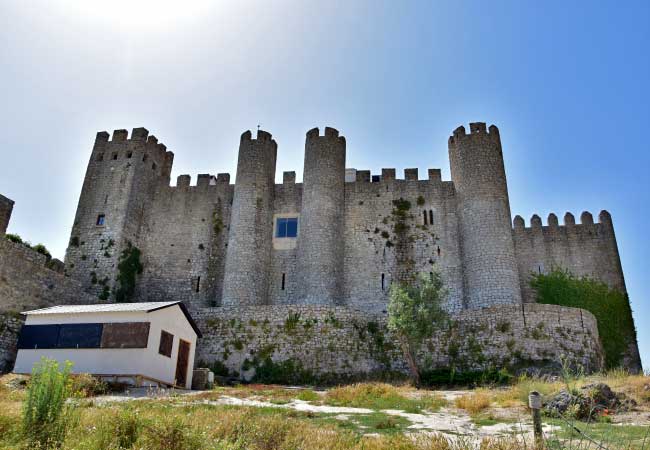
The mighty Óbidos castle, as seen from the inner courtyard
The Rua Direita
The Rua Direita is the main street of Óbidos and is a bustling shopping street filled with handicraft stalls and tourist gift shops.
The street connects the Porta da Vila to the castle and has been the main thoroughfare of Óbidos since the 14th century. It was expanded during the 16th and 17th centuries, but many original Gothic features can still be seen within the whitewashed houses, such as arched windows and tiny doors.
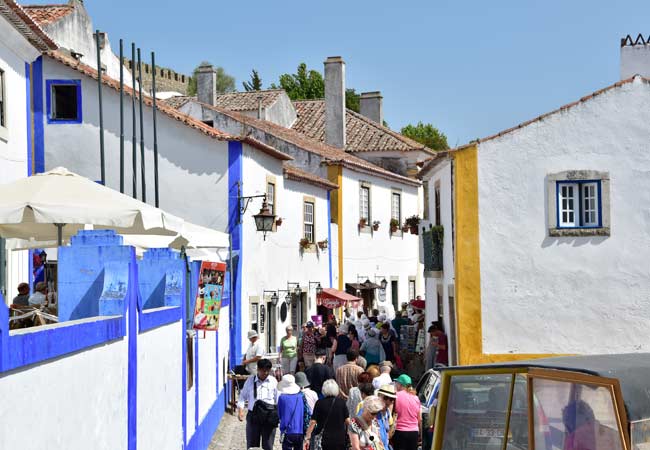
The narrow Rua Direita is always packed with tourists
The Igreja de Santa Maria church
The Igreja de Santa Maria, Óbidos' main church, has a rich religious history. Originally a Visigoth temple, it became a mosque during Moorish rule before being converted to a Christian church in 1148 when King Afonso Henriques captured Óbidos.
The current church dates from the 16th-century, rebuilt under the patronage of Queen Leonor after an earthquake in 1535 damaged the original Gothic structure. This reconstruction embraced the Renaissance style, marking a shift from the medieval architecture of its predecessor.
As you enter through the ornate Renaissance portal, you'll find an interior adorned with decorative azulejo tiles and Gothic religious art, reflecting the church's layered past.
The Igreja de Santa Maria gained historical significance in 1444 when it hosted the wedding of King Afonso V to his cousin Isabel. This royal union, arranged for political reasons, was notable for the young age of the couple, the king was just 10-years-old, while his bride was only 8.
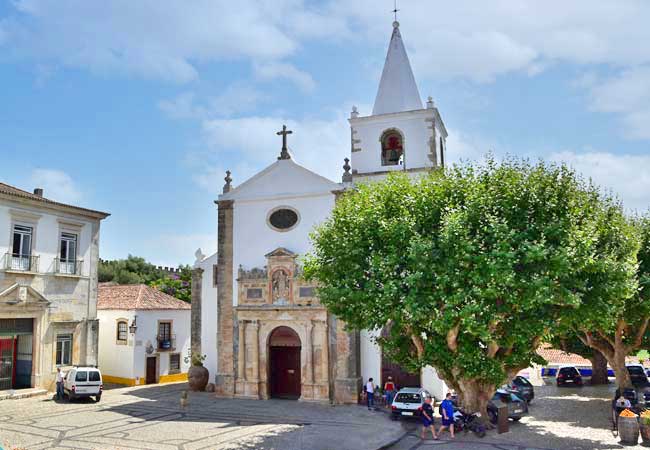
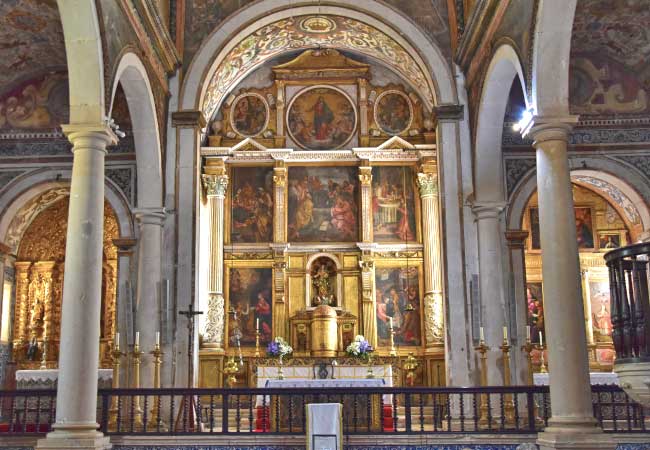
The beautiful painted interior of the Igreja de Santa Maria
Josefa de Obidos
Josefa de Óbidos was the only professional female painter in 17th-century Portugal and became Óbidos' most renowned resident. Born in Seville in 1630 as Josefa de Ayala Figueira, she moved to the town at age four and made it her lifelong home.
Josefa carved out a unique place for herself in the art world and ran a successful studio in Óbidos, choosing to remain here even when invited to the royal court in Lisbon.
Josefa's connection to Óbidos was so strong that she often signed her works as "Josepha em Obidos". Her prolific career produced over 150 pieces, with subjects ranging from still lifes to religious scenes. You can see one of her most famous works, the Mystic Betrothal of Saint Catherine, in the Igreja de Santa Maria.
Pelourinho de Óbidos (Óbidos Pillory)
The Pelourinho de Óbidos stands in the Praça de Santa Maria, a stark reminder of medieval justice. This 15th-century granite pillory was once used for the public punishment and humiliation of criminals.
The structure was a gift to Óbidos from Queen Leonor, who sought solace in the town after the mysterious death of her only son in 1491. Look closely, and you'll spot the queen's emblem - fishing nets - carved into the stone.
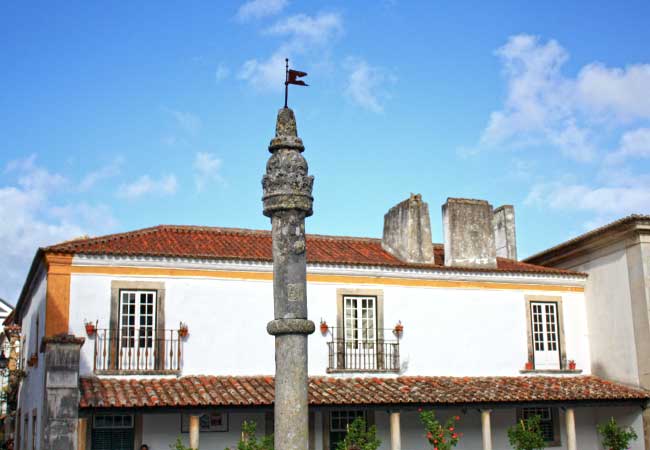
The Óbidos Pillory
Aqueduto de Óbidos (Óbidos Aqueduct)
The Aqueduto de Óbidos aqueduct was constructed in the 16th century to provide a constant supply of water to Óbidos. The aqueduct extends for 3km to the southeast of Obidos, and there is a further 3km of tunnels to the source of the water at the Usseira River.
The aqueduct features 127 arches, some reaching 30 meters high, built with limestone blocks without mortar. The project was funded by Queen Catherine, who sold her lands that surrounded Obidos to pay for the construction. Remarkably, the aqueduct still feeds some of the town's historic fountains today, a remarkable example of its enduring engineering.
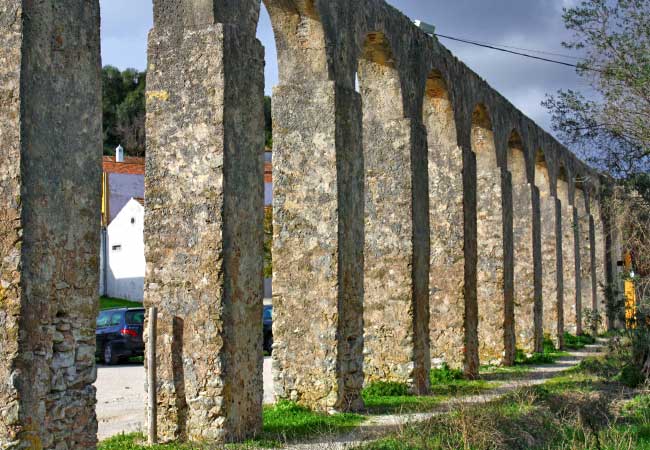
The Santuário do Senhor Jesus da Pedra
The Santuário do Senhor Jesus da Pedra is a striking baroque church just outside Óbidos' ancient walls. Built between 1740 and 1747, it's known for its unique hexagonal shape and pyramidal, green-glazed roof. Inside, the unusual six-sided layout focuses on the stone crucifix on the altar, which gives the sanctuary its name.
Legend says this cross has stood here since the 2nd century. The church's grand baroque façade and marble statues of saints reflect the opulent taste of King João V, in whose honour it was built.
Museu Municipal de Óbidos
The Museu Municipal de Óbidos, housed in an 18th-century manor on Rua Direita, showcases the town's rich cultural heritage. Its collection includes sacred art from the 15th to 18th centuries, with notable works by Portuguese artists like Josefa de Óbidos and André Reinoso. The museum displays archaeological artifacts, baroque furniture, and French and English weapons from the Napoleonic Wars. It is open Tuesday to Sunday, 9:30 AM to 5:30 PM and closed Monday.
Igreja São Pedro Óbidos
The Igreja de São Pedro, originally a Gothic structure from the 13th-14th centuries, was largely rebuilt after the 1755 earthquake. The reconstruction blended Baroque and Neoclassical styles, while preserving the 17th-century portal and bell tower.
Inside is a magnificent gold-covered altarpiece and notable paintings, including works by João da Costa. The church is also the final resting place of the renowned local artist Josefa de Óbidos.
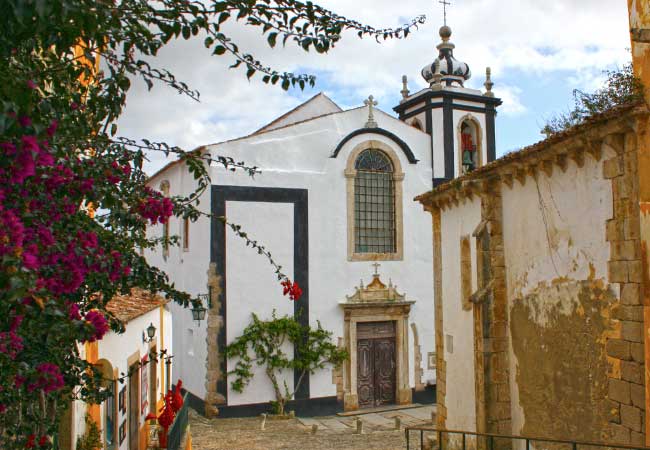
The Capela de São Martinho
The Capela de São Martinho, founded in 1331, is Óbidos' only fully intact medieval building. This Gothic chapel features an ogival portal with three archivolts and a rib-vaulted interior. Inside, you'll find three tombs set in pointed arches, one adorned with a sculpted sword
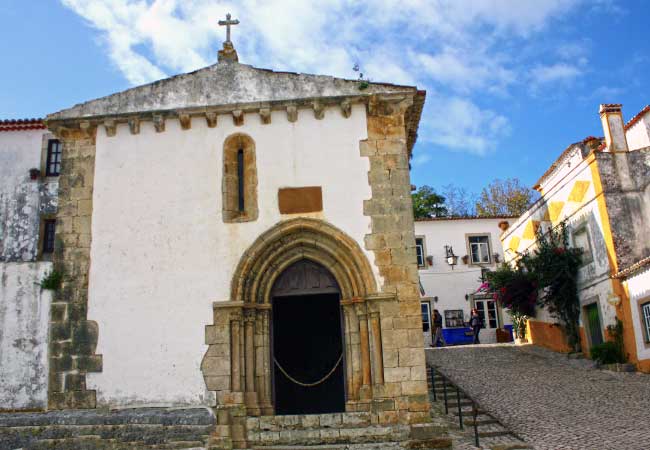
Buddha Eden
A short drive from Óbidos lies one of the region's most unexpected and spectacular attractions: the Buddha Eden Garden. Sprawling across 35 hectares of a former vineyard, it is the largest oriental garden in Europe and offers a surreal and peaceful escape. The garden was created by Portuguese art collector José Berardo as a response to the destruction of the Giant Buddhas of Bamiyan in Afghanistan, serving as a tranquil space for reflection.
As you explore, you will wander through a remarkable landscape of serene lakes, palm trees, and modern sculptures. The garden is filled with an astonishing collection of art, including giant golden Buddhas, a mesmerizing army of hand-painted terracotta warriors, and contemporary art installations from various international artists. Buddha Eden is located just a 15-minute drive from Óbidos and is a highly recommended addition to your trip.

Lagoa de Óbidos (Óbidos Lagoon)
For a complete change of pace from the historic streets and stone walls, head to the nearby Lagoa de Óbidos. This is the largest coastal lagoon system in Portugal, a stunningly beautiful expanse of saltwater separated from the rolling waves of the Atlantic Ocean by a sandy spit. It offers a refreshing natural escape and a glimpse into the region's diverse landscape, which once saw the sea reach the very base of Óbidos hill.
Its calmer inland waters are perfect for activities like kayaking, paddleboarding, and kitesurfing, while the surrounding area is crisscrossed with scenic trails for walking and cycling. The lagoon is also a vital ecosystem and a haven for birdwatchers, attracting a diverse range of species, including flamingos and herons, throughout the year. The Lagoa de Óbidos is easily accessible by car and well worth the short journey.
Where to eat in Óbidos
Óbidos offers a diverse culinary scene that caters to various tastes and budgets. For a unique dining experience, consider Ja!mon Ja!mon, which serves generous portions of slow-cooked specialties under the arches of the town's 16th-century aqueduct. A Nova Casa de Ramiro provides a cozy cave-like atmosphere.
For those with a sweet tooth, Tasca Torta is famous for its chocolate cake, while also offering fresh seafood options. If you're looking for a meal with a view, Alcaide's terrace overlooks the surrounding hills and serves local specialties.
For a truly memorable experience, consider dining at the Pousada do Castelo, located within Óbidos' medieval castle. This former Michelin-starred restaurant offers gourmet Portuguese cuisine in a regal setting.
For some of the better value establishments, head outside of the town walls to the Largo do Santuário, close to the Santuário do Senhor Jesus da Pedra. The Restaurante Vila Infanta serves good, reasonably priced food and is where the locals tend to eat.
A bit further out (2km north of Óbidos) is the excellent Restaurante O Melro serving traditional Portuguese dishes in a warm, welcoming setting and is popular with both locals and visitors.
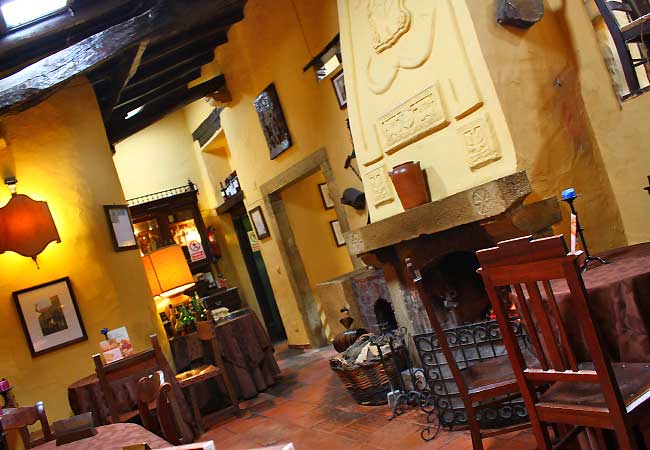
Discover more of Óbidos and central Portugal with our guides
If you've found our content valuable, we'd welcome your support.
The digital publishing landscape has evolved significantly. As a small independent publisher, we face growing challenges. Search engines increasingly favour paid content over organic results, while AI-generated content often reproduces original work without attribution.
To support our work, please consider bookmarking this page (press Ctrl + D) for quick access. If you find an article helpful, we'd be grateful if you'd share it with friends on social media.
For specific questions, please see our Reddit community at r/LisbonPortugalTravel.
Should you notice any outdated or incorrect information, please contact us at [email protected]
Thank you for helping us continue to provide valuable content in an increasingly challenging digital environment.

























